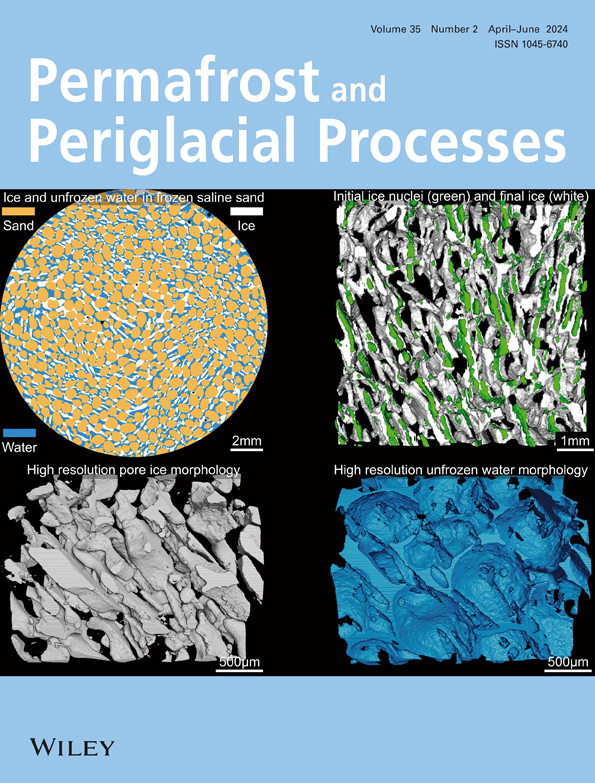高路堤地形对下伏多年冻土层电阻率调查的影响
IF 3.3
3区 地球科学
Q2 GEOGRAPHY, PHYSICAL
引用次数: 0
摘要
摘要电阻率研究已被有效地用于堤防沉降和破坏风险的评估。对于路面上的测量线,通常假设测量对象的二维近似。然而,当在凸起的高路堤上进行电阻率调查时,这种近似可能不符合;在这些条件下,常规逆序可能会产生错误的结果。本研究通过三维高路堤模型的正演和逆演,探讨了高路堤地形对电阻率测量的影响。结果表明,测量线在路面上的二维近似显著提高了凸起路堤深度内的视电阻率。道路肩线和中线测量线的最大相对误差分别达到21%和11%。尽管电阻率对比仍然可以识别层与层之间的界面,但偏视电阻率导致的反向电阻率高于真实值。利用几何因子对视电阻率偏差进行校正,消除高堤地形效应。校正视电阻率反演结果与正演模型吻合较好。通过现场应用验证了该方法的有效性。对青藏高原多年冻土区某高路堤实测资料的视电阻率进行了反演前校正。根据钻孔温度对反演电阻率得到的多年冻土表进行了验证。这些发现表明,需要考虑高堤防地形对电阻率测量的影响。视电阻率的校正是反演电阻率定量解释的必要条件。本文章由计算机程序翻译,如有差异,请以英文原文为准。
Topographical effect of high embankments on resistivity investigation of the underlying permafrost table
Abstract Investigation of resistivity has been effectively used in assessing the risks of embankmentation and failure. A two‐dimensional (2D) approximation of the surveyed object is commonly assumed for a survey line on the road surface. However, this approximation may not be met when resistivity investigations are conducted over a raised high embankment; under these conditions, regular inversions might yield erroneous results. This study explored the topographical effect of a high embankment on resistivity measurements by forward and inverse modeling of a 3D high embankment model. The results show that a 2D approximation of the survey lines on the road surface significantly increases the apparent resistivity within the depth of the raised embankment. Maximum relative errors reached 21% and 11% for the road shoulder and midline survey lines, respectively. The biased apparent resistivity resulted in an inverted resistivity that was higher than the true values, although resistivity contrasts can still identify interfaces between layers. A geometric factor was used to correct the biased apparent resistivity to eliminate the high embankment topographical effect. Inversion results of the corrected apparent resistivity agreed well with the forward model. The method was then verified by field application. The apparent resistivity of the field data collected on a high embankment in permafrost regions on the Qinghai–Tibet Plateau was corrected before inversion. The permafrost table derived from the inverted resistivity was verified based on borehole temperatures. These findings indicate that the topographical influence of high embankments on resistivity measurements needs to be considered. Correction of the apparent resistivity is indispensable for quantitative interpretation of the inverted resistivity.
求助全文
通过发布文献求助,成功后即可免费获取论文全文。
去求助
来源期刊
CiteScore
9.70
自引率
8.00%
发文量
43
审稿时长
>12 weeks
期刊介绍:
Permafrost and Periglacial Processes is an international journal dedicated to the rapid publication of scientific and technical papers concerned with earth surface cryogenic processes, landforms and sediments present in a variety of (Sub) Arctic, Antarctic and High Mountain environments. It provides an efficient vehicle of communication amongst those with an interest in the cold, non-glacial geosciences. The focus is on (1) original research based on geomorphological, hydrological, sedimentological, geotechnical and engineering aspects of these areas and (2) original research carried out upon relict features where the objective has been to reconstruct the nature of the processes and/or palaeoenvironments which gave rise to these features, as opposed to purely stratigraphical considerations. The journal also publishes short communications, reviews, discussions and book reviews. The high scientific standard, interdisciplinary character and worldwide representation of PPP are maintained by regional editorial support and a rigorous refereeing system.

 求助内容:
求助内容: 应助结果提醒方式:
应助结果提醒方式:


